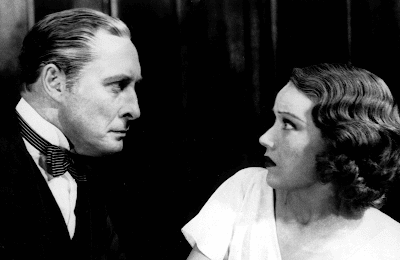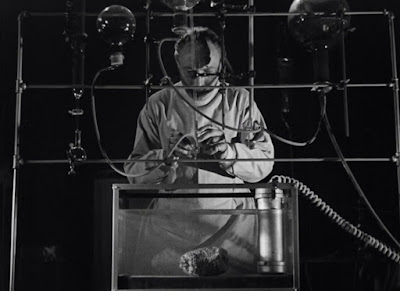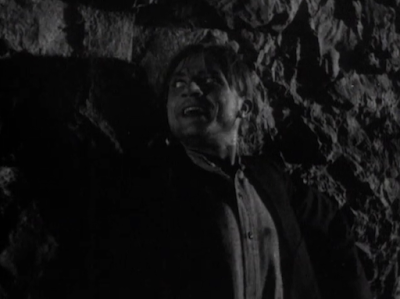The Vampire Bat (1933, directed by Frank R. Strayer) is filmmaking opportunism at its finest. Its studio, Majestic Pictures, had a reputation for turning out higher quality product than its poverty row brethren, in part because the studio had a habit of renting out the facilities of bigger studios when those facilities were idle. That's what happened here. The producers filmed great whacks of the film on the sets Universal built for Frankenstein and The Old Dark House, and borrowed a number of character actors from Universal to give it the appearance of being a new Universal production. Lionel Belmore, who played the Burgomaster in Frankenstein, plays the Bürgermeister here as if this film was set in the same universe. Dwight Frye appears here, too, and you could be forgiven for mistaking him for Renfield's imbecile cousin. It's practically the same performance. The real impetus for this film was making use of the two stars of Warner Brothers' Doctor X and The Mystery of the Wax Museum. Doctor X had been a substantial hit, and The Mystery of the Wax Museum had every indication of surpassing it. But the latter film's production took longer than expected and both Fay Wray and Lionel Atwill were idle at the time. Wray already had experience with waiting out complicated productions, having already starred in The Most Dangerous Game while the special effects for King Kong were being completed, using Kong's sets and technicians. In stepped Majestic, with a production ready to go for the two actors. Melvyn Douglas, fresh off James Whale's The Old Dark House, completed the cast. The film beat The Mystery of the Wax Museum into theaters by a little over a month, letting Warners' publicity department do the heavy lifting. Given the improvisational nature of its production, it's a miracle that the film is watchable at all. Seriously, there's no reason at all for this to have turned out to be a good movie. It's a rip off at its core. And yet...this is surprisingly entertaining. Personally, I think the secret ingredient is Melvyn Douglas. He was a talent much too large to stay confined in the horror movie. Fay Wray and Lionel Atwill (and to a lesser extent Dwight Frye) are talents too big for poverty row, too, though perhaps not too big for horror films. Fay Wray made five of them in quick succession in 1932, and they are the films for which she is best remembered. This is a film where the cast provides the alchemy that makes the movie work, which is a good thing because the script has serious deficiencies. To quote The Bard, it's a tale told by an idiot...
The story involves a series of murders in the village of Kleinschloss, presumably somewhere in central Europe. The victims have been exsanguinated and there are two puncture wounds on their bodies, leading the superstitious people of the village to blame a vampire. The sensible police inspector, Karl Brettschneider, is more skeptical. He's convinced it's a human murderer hiding behind the superstition. As the film opens, the latest victim is one Martha Mueller, who has been cared for by the mentally disabled Hermann, who likes bats. "Nice and soft like cat" he says. Unfortunately, his affinity for bats draws the eye of the townsfolk, particularly after one of them claims to have been attacked by a vampire bat. "Poppycock," Brettschneider says. The vampire bat is real, but is native to South America. The medical consultant in the case is Dr. Otto von Niemann, a scientist. He has two assistants: Emil and Ruth. Brettschneider is sweet on Ruth. Ruth lives with her hypochondriac Aunt, who has a run in with Hermann just after another murder, sending the townsfolk into a rage. They hound Hermann to ground, ending in tragedy, but Hermann's death provides him with an alibi when the killer strikes within Dr. von Niemann's own household. Von Niemann has secrets, not least of which is his experiment with the creation of life, and the strange hold he has over his servants...
One doesn't need to squint very hard to see the lineage of this film's plot. There's a bit of Dracula here, and a bit of Frankenstein, and the strong influence of Svengali. Given the mash-up nature of its script, it's not a surprise that screenwriter Edward T. Lowe would go on to write Universal's House of Dracula and House of Frankenstein. Lowe understood the assignment here. Make this film as familiar to a horror audience as possible. Logic does not matter, and was consequently thrown to the wind. The film has two supernatural premises, and neither of them involves actual vampires. The first is that Von Niemann is able to control weak willed people with telepathy. The second is that he's growing an artificial organism in his lab, which is why he needs the blood. This is where the film loses the plot, because Von Neimann has a profound lack of imagination when it comes to using his gifts. There's a passage in one of Chelsea Quinn Yarbro's vampire stories that suggests that if actual vampires went around acting like Christopher Lee in the Horror of Dracula, they would never live to a hundred years, let alone four hundred, because the monster hunters will come out of the woodwork. I thought of that here, because everything about Von Neimann screams "mad scientist!" and he bloody well ought to be smart enough to avoid this. If, indeed, he has the power to cloud men's minds, he could credibly convince people to just donate blood. No murder involved. No police investigation. He can grow his chicken heart or his Audrey II to his heart's content. But no. The film paints Hermann as an imbecile, but y'know? I can get behind his love of bats. I like bats. And in this, and other things, Hermann is a lot smarter than the supposed genius scientist. Plus, Hermann has empathy. When Von Niemann goes on a rant about how his victims should be happy that they're contributing to his great work, it's hard to block the film's time period from one's mind because this is the kind of dude who would be working in a concentration camp torturing twins or something ten years later. The ideology is definitely there. It's not lost on me that Hermann is exactly the kind of victim who was first to the ovens.
Which brings me to my next point:
The angry mob just flat out murders Hermann and their penance for this is to "give him a decent burial?" I mean, it's bad enough that they hounded him to death in one of Hollywood's more familiar caves, but to ad insult to injury they drive a fucking stake through his heart. And Brettschneider just lets that go? Jesus. All cops really ARE bastards. But what the hell, this isn't The Ox-Bow Incident I guess, and more's the pity. Brettschneider is otherwise a big step up on Universal's usual hero characters. He has a forceful personality and his skepticism is close to my heart. Plus, he has actual movie star charisma, something David Manners and John Boles absolutely did not.
Fay Wray made three horror movies with Lionel Atwill and their characters have different relationships in all three films. And yet in all three films, she winds up as the designated victim who the hero must save at the last minute. There's a ritual quality to this, a repeating archetype even. In truth, none of her horror movies, not even the film with which she is synonymous, makes good use of her talents. Maybe that's why she stopped making them after 1932. Atwill, by contrast, remained in the genre. He was precisely the kind of ham that horror movies of the 1930s required and he made a lot of them. In a fair universe, he's remembered as fondly as Karloff or Lugosi, but you can never tell what the culture will remember. Atwill has the showiest part in this film and he devours it once the mask is off (metaphorically in this film, rather than literally in one of his other films with Fay Wray). He's well directed, too, which is unusual in some of the horror films he made (or, at least, the ones not directed by Michael Curtiz).
Frank R. Strayer directed a ton of films, including most of the Blondie films in the 1930s. I've seen a couple of those, but I couldn't tell you which ones off the top of my head. They tend to blur together. The only other film of his that I've seen is Condemned to Live, which is suggestive of a director who could have made a living in horror movies had he so desired. He never seems to have graduated from poverty row, though, so who knows? This is the film for which he's best remembered and he did more than competent work here. He keeps things moving at a good clip and even has a sense of blocking in depth at a time when many directors on similar productions just kept to the proscenium or used the medium two-shot as a crutch. The scene near the end of this film when the murderer comes in through Brettschneider's window when he's sleeping is particularly effective and is particularly cinematic. Strayer is good with the actors, too. He knows he has a good cast and he gives them their heads. Mostly, Strayer doesn't dawdle, and by not dawdling, he keeps the audience from dwelling on the deficiencies of the screenplay. This is the kind of job that suggests why film is generally a director's medium, because a bad job of directing this material would have torpedoed the whole thing. The Vampire Bat isn't a bad film on which to stake one's reputation. It's maybe not a silk purse from a sow's ear, but it's the same kind of legerdemain.
Welcome to this year's October Horror Movie Challenge. I'm participating in my friend, Aaron Christensen's annual fundraiser during this year's challenge. Aaron has chosen the Women's Reproductive Rights Assistance Project as this year's recipient for our community's largess, so if you've got a few bucks lying around, here's a donation link for the donor drive. You know what to do.
As usual with the challenge, I'll be prioritizing films that are new to me, so I'm off to a good start there. I'll also be prioritizing pre-Code and silent horror this year, because during the last few decades, the genre has gotten too big to really track and I feel a need to go back to the basics. We'll see how it goes.
My current progress:
New to me films: 3
Total films: 5

This blog is supported on Patreon by wonderful subscribers. If you like what I do, please consider pledging your own support. It means the world to me.




















No comments:
Post a Comment